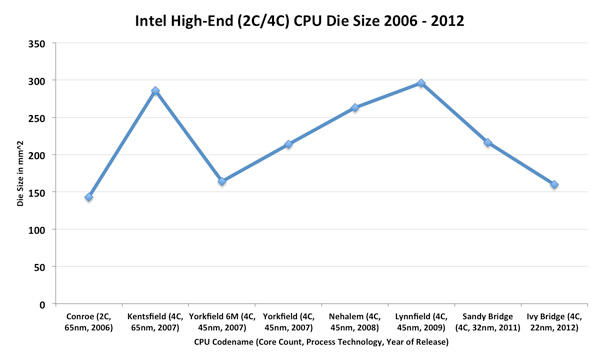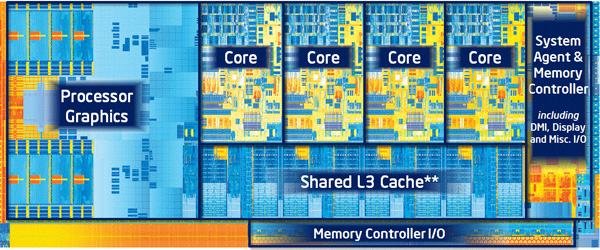The Intel Ivy Bridge (Core i7 3770K) Review
by Anand Lal Shimpi & Ryan Smith on April 23, 2012 12:03 PM EST- Posted in
- CPUs
- Intel
- Ivy Bridge
Die Size and Transistor Count
At IDF last year we got word of Ivy Bridge's transistor count (1.4 billion), however today we know its die size: 160mm2. That's 75% the size of a quad-core Sandy Bridge, but with 20% more transistors.
This marks the first time since 2006 that Intel is offering a high-end desktop CPU with this small of a die size. I'm excluding the 6-core parts from the discussion since that line isn't really aimed at the same market anymore. The chart is even more insane when you consider the Ivy Bridge die size includes an integrated GPU alongside four of the highest performance x86 cores Intel has ever shipped. Remove the GPU and Ivy Bridge is even smaller than Conroe. A hypothetical GPU-less Ivy Bridge would measure in at roughly 113mm^2 chip on its 22nm process, making it smaller than any high-end Intel CPU since the days of the Pentium 3.
| CPU Specification Comparison | ||||||||
| CPU | Manufacturing Process | Cores | Transistor Count | Die Size | ||||
| AMD Bulldozer 8C | 32nm | 8 | 1.2B | 315mm2 | ||||
| Intel Ivy Bridge 4C | 22nm | 4 | 1.4B | 160mm2 | ||||
| Intel Sandy Bridge E (6C) | 32nm | 6 | 2.27B | 435mm2 | ||||
| Intel Sandy Bridge E (4C) | 32nm | 4 | 1.27B | 294mm2 | ||||
| Intel Sandy Bridge 4C | 32nm | 4 | 1.16B | 216mm2 | ||||
| Intel Lynnfield 4C | 45nm | 4 | 774M | 296mm2 | ||||
| Intel Sandy Bridge 2C (GT1) | 32nm | 2 | 504M | 131mm2 | ||||
| Intel Sandy Bridge 2C (GT2) | 32nm | 2 | 624M | 149mm2 | ||||
Ivy Bridge is tiny—but what does this mean? For starters, it means the obvious—Intel has little competition in the desktop space. I'm always hard on AMD in my meetings with them because of this reason alone. A less than competitive AMD means we get a less aggressive Intel.
More importantly however, a tiny Ivy means that Intel could have given us a much bigger GPU without breaking the bank. I hinted at this possibility in our Ivy Bridge architecture article. Unfortunately at the time only Apple was interested in a hypothetical Ivy Bridge GT3 and rumor has it that Otellini wasn't willing to make a part that only one OEM would buy in large quantities. We will eventually get the GPU that Apple wanted, but it'll be next year, with Haswell GT3. And the GPU that Apple really really wanted? That'll be GT4, with Broadwell in 2014.
All of this being said however, we must keep in mind that Ivy Bridge is both faster than Sandy Bridge and no more expensive. If we look at the supply and pricing constraints that accompany TSMC's 28nm process, the fact that Intel is able to ramp up 22nm and ship the first products without any price increase is something we shouldn't take for granted.












173 Comments
View All Comments
JarredWalton - Tuesday, April 24, 2012 - link
I don't think it's a mystery. It's straight fact: "One problem Intel does currently struggle with is game developers specifically targeting Intel graphics and treating the GPU as a lower class citizen."It IS a problem, and it's one INTEL has to deal with. They need more advocates with game developers, they need to make better drivers, and they need to make faster hardware. We know exactly why this has happened: Intel IGP failed to run for so long that a lot of developers gave up and just blacklisted Intel. Now, Intel is actually capable of running most games, and so long as they aren't explicitly blacklisted things should be okay.
In truth, the only title I can think of from recent history where Intel could theoretically work but was blacklisted by the game developer is Fallout 3. Even today, if you want to run FO3 on Intel IGP (HD 2000/3000/4000), you need to download a hacked DLL that will identify your Intel GPU as an NVIDIA GT 9800 or something.
And really, there's no need to blacklist by game developers, because you can't predict the future. FO3 is the perfect example: it runs okay on HD 3000 and plenty fast on HD 4000, but the shortsighted developers locked out Intel for all time. It's better to pop up a warning like some games do: "Warning: we don't recognize your driver and the game may not run properly." Blacklisting is almost more of a political statement IMO.
craziplaya21 - Monday, April 23, 2012 - link
I might be blind or something but did you guys not do a comparison between an original bluray IQ vs an encoded 1080p IQ by quicksync??toyotabedzrock - Monday, April 23, 2012 - link
Why is Intel disabling this on the K parts? And why disable vPro?jwcalla - Monday, April 23, 2012 - link
First, a diversion: "I was able to transcode a complete 130 minute 1080p video to an iPad friendly format..." Just kill me. Somebody please. Why do consumers put up with this crap? Even my ancient Galaxy S has better media playback support.It's the same story with my HP TouchPad: MP4 container or GTFO. Who can stand to re-encode their media libraries or has the patience to deal with DLNA slingers when the hardware is perfectly capable of curb-stomping any container / codec you could even conceive? Just get an Android tablet if this is the crap they force on you. Or, in the TouchPad case, wipe it and install ICS.
As for the article... did I totally misunderstand the page about power consumption? I got the impression that idle power is relatively unchanged. I must be misreading that. Or maybe the lower-end chips will show a stark improvement. Otherwise I totally miss the point of IVB.
I'm beginning to lose confidence in Intel, at least in terms of innovation. These tick-tock improvements are basically minor pushes in the same boring direction. From an enthusiasts' perspective, the stuff going into ARM SoCs is so much more interesting. Intel makes great high-end CPUs but it seems that these are becoming less important when looking at the consumer market as a whole.
Anand Lal Shimpi - Monday, April 23, 2012 - link
Idle power didn't really go down because at idle nearly everything is power gated to begin with. Any improvements in leakage current don't help if the transistors aren't leaking to begin with :)Your ARM sentiments are spot on for a huge portion of the market however. Let's see what Haswell brings...
Take care,
Anand
thomas-hrb - Monday, April 23, 2012 - link
I disagree with the testing methodology for the World of Warcraft test. Firstly no gamer of any game buys hardware so they can go to the most isolated areas in a game. Also the percentage of who can pay for one of these CPU's who would be playing at 1650x1050, would be pretty small.I've been playing WoW for a number of years and I don't care about 60fps+ because my monitor won't display it anyway. I care about minimum fps and average fps. nVidia's new adaptive vsync is a great innovation, but I am sure there are other tests that while not as controlled and repeatable is a much indicative of real world performance (the actual reason behind purchasing decisions).
One possible testing methodology you could look into is to take a character into one of the topend 25man raids. There are 10 classes in WoW and my experience is that a 25man raid will show up every single possible spell/ability and effect that the game has to offer in fairly repeatable patterns.
I agree that it is not the most scientific approach but I put more stock in a friend saying "go buy this cpu/gpu you can do all the raids and video capture and you get no lag" than you telling me that this cpu will give me 100+ fps in the middle of nowhere. There is a fine line between efficient and effective. I am just hoping that you can dial down the efficiency and come up with a testing methodology that actually produces a metric I can use in my purchasing decisions. After all that is one of the core reasons most people read reviews at all.
redisnidma - Monday, April 23, 2012 - link
Expect Anand's Trinity review to be heavily biased with lots of AMD bashing.This site is so predictable...
Nfarce - Monday, April 23, 2012 - link
Oh boy. Another delusional red label fangirl. Maybe when AMD gets their s**t together Anandtech will have something positive to review in comparison to the Intel offerings at the moment. Bulldozer bulldozed right off a cliff. And don't get me wrong: I WANT AMD to whip out some butt-kicking CPUs to keep the competition strong. But right now, Intel is not getting complacent and keep stepping their game up when the competition isn't even on the same playing court. But that's just for now. If AMD continues to falter, Intel may not be as motivated to stay ahead and spend so much R&D in the future. After all, why put the latest F1 car on the track when the competition can only bring a NASCAR car to every track?Reikon - Monday, April 23, 2012 - link
Temperature is in the overclocking article.http://www.anandtech.com/show/5763/undervolting-an...
rickthestik - Monday, April 23, 2012 - link
An upgrade for me makes sense as my current cpu is an Intel Core 2 Quad and the new i7-3770K will be a pretty significant upgrade...2.34Ghz to 3.5Ghz and the heaps of additonal tech to go with it.I could see a fair number of Sandy Bridge owners holding off for Haswell, though for me this jump is pretty big and I'm looking forward to seeing what the i7-3770K can do with the Z77 motherboards and a shiny new PCI 3.0 GPU.